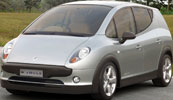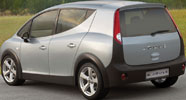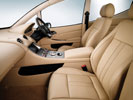

A South African company called Optimal Energy has developed an electric vehicle that recently débuted at the 80th International Motor Show in Geneva, in a form tantalisingly close to the planned production version.
Known as the Joule, the car has garnered much media interest leading up to its launch, the highlight being a spot in a recent episode of Carte Blanche.
Designed by South African-born Keith Helfet, Joule has been developed from a static display model and engineering prototype into a pre-production prototype by Zagato, and formed the centrepiece of a stand at Geneva shared by Optimal Energy and the Milanese design house. The design team has made a number of changes to Joule and the car shown in Geneva is somewhat different, especially at the rear, from the version first unveiled in Paris two years ago. This car was hand-built near Port Elizabeth by Hi-Tech Automotive, which is responsible for building a marketing and test fleet of approximately 100 vehicles. These will double as research and development units, some of which are scheduled to be on South African roads by the start of the Soccer World Cup in June.
Full-scale production of Joule will begin at the end of 2012, with cars in showrooms by mid-2013. Key design goals for the finished product include a range of 230 kilometres based on the New European Driving Cycle (NEDC) or 300 km using the Urban Dynamometer Driving Schedule (UDDS), integration with existing charging infrastructure, a genuine freeway cruising capability, seating for five, a 4-star NCAP safety rating and a retail price of 24 300 Euros in today’s terms.

Establishing partnerships
Optimal Energy has signed a memorandum of understanding with EDAG, a German automotive full service supplier, to industrialise the Joule. EDAG has built an outstanding reputation working with many well known carmakers over the past 40 years, and Optimal Energy is exploiting this partnership to ensure that the best of German automotive engineering will be integrated into the series production Joule.
Optimal Energy has also signed a memorandum of understanding with Energy Innovation Group (EIG), a South Korean lithium battery cell supplier, to explore the potential of setting up a manufacturing facility in South Africa, for the non-exclusive supply of cells to Optimal Energy. The Industrial Development Corporation of South Africa (IDC), as a potential investor, is also party to this memorandum; the IDC is currently an investor in Optimal Energy.
Announcing its 2010–2013 industrial policy action plan recently, the Department of Trade and Industry (DTI) of South Africa specifically addressed the commercialisation of South Africa’s electric car. This includes the provision of appropriate support to encourage local manufacture of electric vehicles (EVs) and related components, infrastructure roll-out for such, creation of testing facilities, provision of demand stimulation mechanisms and public education on the use and benefits of alternative energy source vehicles.

Under the hood
From the outset, Joule was conceived as a fully electric vehicle, with all aspects of its design – from the styling to the safety features – reflecting this. Ex-Jaguar stylist Keith Helfet came up with a shape that emphasises design and practicality, yet has a drag coefficient that underlines aerodynamic efficiency. Joule will also boast a list of features to make it user-friendly, including clever packaging, an infotainment system, connectivity and navigation.
Battery
The Joule is powered by a 36 kWh traction battery, the function of which is to provide the energy required to power the car’s electric motor. In order to fulfil this function, the battery controller manages the energy transfer during charge, discharge and regeneration, a process that involves complex monitoring processes as well as sophisticated communication with other vehicle systems.
The traction battery consists of a number of modules, each module containing Lithium-ion cells. These cells are at the forefront of battery technology and safety, and have a high specific energy density. This allows the Joule to achieve the desired range without the mass penalty of older technology batteries. The battery pack is mounted onto battery trays which slot into the vehicle from below and which can be replaced within a few minutes. These trays form an integral part of the structure, and their location serves to ensure a low centre of gravity, which reflects in the Joule’s handling characteristics.
Brakes
The all-wheel disc braking system provides excellent braking performance, including safety features such as ABS. Joule is also equipped with a regenerative braking system which, during deceleration, converts kinetic energy into electrical energy. This is used to recharge the traction battery, thus extending the range of the vehicle. The regenerative braking system operates separately from the standard brakes and is actuated when the accelerator pedal is released. This allows virtual ‘single pedal driving,’ providing easy and comfortable control of the car.
Chassis
The design of the chassis ensures that the vehicle’s mass is kept to a minimum without compromising crash safety or handling characteristics. This has been achieved by making the battery tray an integral part of the chassis, maintaining stiffness and strength without adding mass. The judicious use of high strength steels also ensures that mass is reduced without sacrificing strength.
Motor
Propulsion is by means of a transversely mounted synchronous permanent magnet motor providing 75 kW peak power and a peak torque of 280 Nm. The motor drives the front wheels through a 7,4:1 single speed reduction gearbox/differential unit. Acceleration from standstill to 60 km/h is less than five seconds, while 100 km/h comes up in under 15 seconds. Maximum speed is 135 km/h, making Joule suitable for highway driving.
Powertrain management
A uniquely integrated computer developed from EV-specific architecture controls all of Joule’s onboard systems and ensures – amongst other things – that the instant torque available on pull-away is properly managed to prevent wheel spin. An integrated, programmable onboard charger ensures that no external charging infrastructure is required and that charging can be synchronised with off-peak electricity.
Solar panel
A photovoltaic solar panel mounted on Joule’s roof will be offered as an option. The energy generated by this panel may be used in various ways, internal environmental control being the most efficient. Electricity generated in this manner can also be fed back into the traction battery or used to power ancillaries such as daytime running lamps or entertainment systems.
Home charging
The charging system has been designed to be intuitive, automatic and safe, allowing Joule to be simply plugged in and left to charge. Normal charging is from a single-phase 230 V/16 A supply to a charge point located on the Joule.
Towards the end of integrating with existing charging infrastructures, integration with modern ‘Smart Grid’ electrical networks is being investigated, so as to optimise energy usage and provide Joule users with cost-effective charging options.
For more information contact Optimal Energy, +27 (0)21 462 7804.

© Technews Publishing (Pty) Ltd | All Rights Reserved